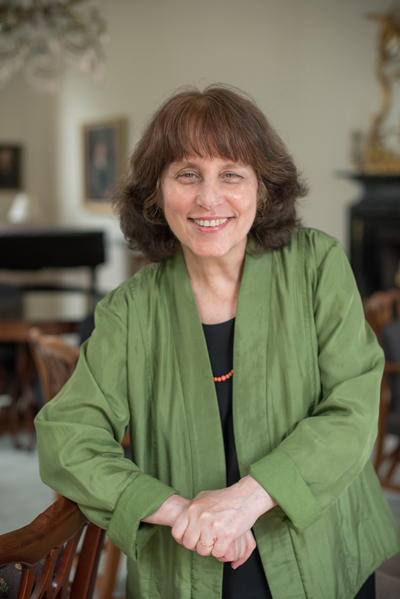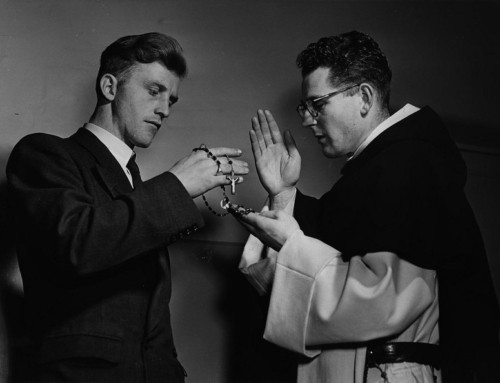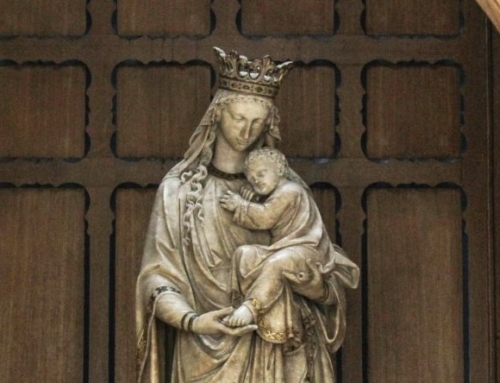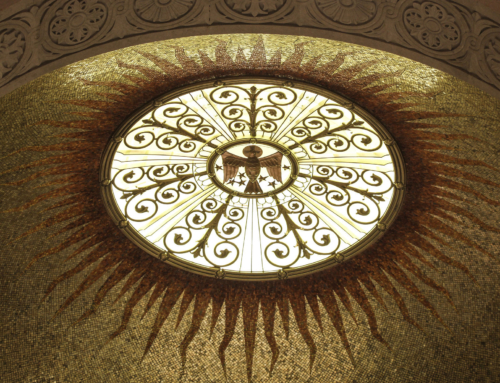Carol Zaleski is the Professor of World Religions at Smith College in Northampton Massachusetts, where she has been teaching philosophy of religion, world religions, and Catholic thought since 1989. She is the author of Otherworld Journeys: Accounts of Near-Death Experience in Medieval and Modern Times (Oxford University Press) and The Life of the World to Come: Near-Death Experience and Christian Hope (Oxford University Press); and she is co-author with Philip Zaleski of Prayer: A History (Houghton Mifflin), The Book of Heaven (Oxford University Press), and The Fellowship: The Literary Lives of the Inklings: J.R.R. Tolkien, C. S. Lewis, Owen Barfield, Charles Williams (Farrar, Straus & Giroux).
Would you tell us something about yourself and how you came to the faith?
I grew up in Manhattan, just north of the Lower East Side, as the only child of parents who were cultured, kind, politically progressive, secular Jews. I never saw the inside of a synagogue except when I attended the bar mitzvahs of two friends. At one point I asked to receive Jewish instruction, but my parents—I can’t recall if they gave a reason—didn’t seem to like the idea. My father told me he had stopped believing in God as a teenager when his own father died suddenly of a heart attack. My mother’s Russian émigré parents were passionate about politics and music. On that side of the family there were Communists, Socialists, Wobblies, poets, composers, and members of the Ethical Culture Society, but no rabbis nor any traces I can detect of active Jewish observance.
Carol Zaleski
Where did the religious influence come from, then? Why Christianity?
My parents loved music, travel, and the arts. On Sundays, as we read The New York Times—which was massive enough to have been almost an all-day affair—we listened to Vivaldi, Bach, and Brubeck. I had the liner notes to Bach’s B Minor Mass, and I read the words. The Agnus Dei made an especially deep impression. I don’t recall analyzing it at the time, but the effect was something like what William James calls “subconscious incubation.” I was reminded of this last week when we were discussing Augustine’s Confessions in one of my classes and we came to the part where Augustine says that the name of Christ was imprinted on him from infancy. No philosophy from which this name was absent—however profound or beautiful—could ultimately satisfy him. In retrospect, I think that was my situation, too. But of course there were many other influences as well.
Can you describe some of these other influences?
My beloved maternal grandmother gave me my first Bible because she heard that I had a part in a summer camp production of J. B. (the Archibald McLeish play based on the Book of Job). It was The Bible as Literature. She also gave me a copy of Ignazio Silone’s novel Bread and Wine. The socialism was familiar, but the sacramentalism was a revelation. And that same summer, to round out my education, she gave me Jean-Paul Sartre’s autobiography, Les Mots (The Words), which I found fascinating. It turned out that the Word had more staying power (even if at first only “as literature”) than The Words.
When I was in high school, a history teacher suggested I give a report on the Catholic Worker movement. So I visited the Catholic Worker House of Hospitality on Chrystie Street in lower Manhattan, gave my report at school, and kept going back on weekends to help out in the soup kitchen and the mailroom. These were the first Christians I was conscious of meeting, and it seemed to me that they were actually living the apostolic life.
In college I studied ancient philosophy, beginning with the Presocratics. The idea that everything might be made of one substance—whether air, water, or some incalculable infinite force—attracted me because it was a unified vision of reality. Plato was even better, of course, and when I move on from Plato to Augustine, I was pretty well sunk.
In college and graduate school I continued studying medieval Christian writers, but I held back from entering the Church for many years because I couldn’t bear the thought of renouncing my Jewish heritage. How could I make a move that would gratify the anti-Semites of this world?
It was an insoluble problem—at least not one that I could solve abstractly. But John Henry Newman is right about personal influence. My husband Philip and I got to know the Catholic writers Stratford and Léonie Caldecott (founders of Second Spring in Oxford) during the few years in which they lived near us in Boston; our friendship with the Caldecotts was (and is) a joy and a provocation to get serious. Then one day, by chance or providence, Philip and I visited the chapel shared by the twin Benedictine monastic communities in Petersham, Massachusetts, heard Vespers, and found what would become a spiritual home. The superior of the monks, a scholar of biblical Hebrew and of Rashi’s commentaries, baptized me in the monastic chapel.
So this was the solution?
It was a grace. But though I wish I could echo Cardinal Lustiger’s famous declaration, “je demeure juif!” (“I remain Jewish!”), I’m not entirely sure about that. It’s a complex question. At least I can remain grateful to my Jewish heritage; I can strive to know it better and to convey the Church’s teaching that God’s covenant with Israel is irrevocable (no supersessionism here!). Among other things, it really bothers me when I hear Christians vocalizing the Tetragrammaton, whether in speech or in print. It’s so unnecessary, too.
What is it like teaching at Smith College?
Smith is a beautiful and vibrant liberal arts college for women. Diversity is the watchword, of course, but I am constantly discovering that the diversity in the student body is genuine, not just a slogan. I teach courses in world religions and philosophy of religion, and my students are Muslims, Jews, Mormons, Pentecostals, Catholics, Unitarians, Buddhists, atheists, and so on—and every kind of seeker, too. In world religions classes, we try to see what the world looks like through the eyes of the adherents; I find that this is the best starting point for a scholarly investigation of any religious tradition.
Students are often surprised by what we read when it comes to their own faith tradition (if they have one), but that’s a good thing—it cuts through the fog of familiarity. For instance, when we study Christianity in the world religions course, we read the Greek homily for Holy Saturday that begins “Something strange is happening . . .” and culminates with Christ commanding Adam, “I order you, O sleeper, to awake. I did not create you to be held a prisoner in hell.” This is a wholly traditional way of depicting the Paschal Mystery, visualized in the Anastasis (Resurrection) icons and “Harrowing of Hell” motifs of Christian literature and art. But to the students it is something remarkable and unheard of. The effect is to stir both imagination and intellect. In my experience, this is how learning begins.
What is a religious imagination? How can you nourish it? How can you harm it?
Now that’s a tough question! We’d have to define both terms, religious and imagination. I was a Coleridge fan for a long time, and more recently I’ve been writing about Tolkien. I’m attracted by their view of the imagination as a power that freely shapes manifold impressions into pictures that carry deep meaning and truth. Imagination can help us shake off a passive acquiescence to what reality, in our duller moments, seems to be. In that way, imagination is a handmaiden to faith.
But it’s not necessary to be a creative genius like Coleridge or Tolkien; our imagination is just as active when we are being receptive to the works of God in nature, to art and beauty in culture, to symbol and sacrament in faith. The worst use we can make of imagination (or “creativity”) is to idolize it as an end in itself.
Of course, Catholics possess an inexhaustible source of nourishment for the imagination: we have the liturgy. Unfortunately, in the rush to implement a certain vision of liturgical reform—well, you know what happened. I still cringe when I remember having to sing the Our Father to the tune of “Johnny Angel.” I think things are getting better, though.
Much of what you’ve written about involves death and what comes after. Whence this morbid curiosity?
I’ve never thought of it as a morbid subject—in any case, my focus has been on images and doctrines of eternal life rather than on death and dying. I suppose we are meant to pay attention to last things, as long as we keep a sense of proportion and refrain from wild speculation.
How did you come to write about “near-death experience”?
I spent a year in Paris—my husband Philip and I lived in a cold-water flat on the Île de la Cité—doing dissertation research on twelfth-century views of the imagination. It was interesting material but it didn’t gel. Then I started hearing all those stories of “near-death experience” (some of them with sensational titles like I Was an Atheist Until I Died), and I realized that there were parallels to medieval return-from-death stories. So I ditched the trunk of index cards I had amassed and wrote the thesis that became Otherworld Journeys: Accounts of Near-Death Experience in Medieval and Modern Times. Some readers took it as a skeptical book, since I stressed the cultural shaping of near-death reports; others thought I was a tad too sympathetic. But there’s a third possibility—neither skepticism, nor credulity—which needs to be better understood. And this third possibility, I discovered later, is what the Catholic tradition understands as the art of discerning the spirits: not dismissing private revelations out of hand, but approaching all such testimonies with wise restraint.
What’s your take on the way that American culture presently thinks and talks (or doesn’t think and talk) about death, Heaven, Purgatory, and Hell?
It’s a big muddle. We’re over-exposed to death and violence in the entertainment and news media, but compared to our ancestors we are cut off from a first-hand acquaintance with death. Denial of death isn’t just a cultural phenomenon, though; it’s also a universal psychic defense mechanism. Freud had a point when he said that whenever we think of our own death we imagine ourselves as a spectator—that’s why the Encyclopedia of Philosophy that Paul Edwards edited in the 1960s had two articles on death, one entitled “Death,” and the other entitled “My Death”!
As far as Heaven, Purgatory, and Hell go, the cultural signals are mixed. Heaven is sentimentalized, and Hell is a subject of debate and speculation unmoored from scripture and tradition. My husband and I are working on an anthology on Hell (The Book of Hell, a sequel to The Book of Heaven); but we haven’t been asked to produce a Book of Purgatory, perhaps because of the popular misconception of Purgatory as “Hell Lite.”
With so little time and with so much to read and to learn just about the Catholic faith, why should we read about what other religions might have to say about the afterlife?
I’ve found fascinating (if incomplete) analogues to Purgatory in other religions, which tells me that the doctrine is at once Catholic-specific and the answer to a universal longing.
The afterlife isn’t a stand-alone subject, though. What a civilization thinks about the afterlife is intimately connected to what it thinks about everything else. What is the nature of the human person? What is the purpose of intelligent life? What are the permanent things? It’s good for us to know that our neighbors of other faiths have been inspired to ask the same deep questions.
The Catholic principle—going back to Justin Martyr—is that the seeds of the Logos are scattered through the world’s civilizations. We don’t all need to have expert knowledge of other religions, but we do need to recognize that every seed is precious. This recognition doesn’t have to lead to indifferentism or shallow forms of pluralism.
How do you avoid shallow forms of pluralism?
I follow the teaching in Nostra Aetate and also Dominus Iesus. But I realize that there are some tough problems. Aside from magisterial documents, I’ve never found a theory of religious diversity that fully satisfies me. Either these theories fail—by falling into one trap or another—or they succeed in a way that seems thin, almost tinny, compared to the richness and complexity of the phenomena they explain.
I’m not sure whether it’s from our own thick-headedness or by a wise providential design (probably both!), but we don’t seem to have the full scoop on everything we might like to know. We’re in a parallel, and much more haunting, situation with the problem of evil. Even though there are profound and rationally compelling solutions to the classic problem of evil, suffering and evil confront us with a mystery that chastens and appalls.
The liturgy seems to play an influential role in your thought. Why is that? What’s the connection between liturgy and life?
What the liturgy offers is a new world to live in, with Christ in our midst and the saints all around us, with a meaningful measure of days and times, in an atmosphere of beauty—even if the singing is off-key. There’s a big difference between reading the Bible for private edification (or “as literature”) and reading it within the horizon of a liturgically illumined cosmos. The liturgy gives us a foretaste of heaven—and it makes our day-to-day experience more coherent, hopeful, and alive.
And then there is the Real Presence. Remember what Flannery O’Connor said when the idea was proposed to her that the Eucharist was an excellent symbol of Christ?
How is it working on books with your husband?
We are just different enough and just similar enough to make the collaboration interesting and fruitful. I learned how to write from Philip (when I was in college, one of my professors told me my writing seemed like it was translated from German).
You’ve recently released a book on the Inklings. Lewis and Tolkien in particular seem to have roaringly healthy imaginations, both religious and otherwise (if that’s a real distinction). What do you love in particular about them and their way of seeing the world? What should we know, in brief, about the lesser-known Inklings?
I love their peculiar blend of scholarship, mythopoeic imagination, and Christian faith. Lewis forged a compelling theological vernacular; Tolkien single-handedly created a mythology, complete with invented languages and meticulous backstories, infused with intimations of the Gospel. Lewis and Tolkien were war writers who radiated Christian hope without falling into shallow optimism; they told the Christian story without didactic preachiness; they wedded imagination to reason. The other Inklings followed a variety of career paths, including poet, publisher, biographer, soldier, doctor, lawyer, theater director—and one Dominican priest—but they all found ways to contribute to the same profoundly hopeful Christian humanism.
What writers, artists, stories, do you find yourself returning to? Asked another way, how you enjoy cultivating your own imagination? Any contemporary artists or authors?
I read whatever I am teaching—and I love whatever I read in that context because teaching summons an energy and engagement beyond what I might have supplied on my own. These days it would be mainly Augustine, Anselm, Aquinas, Dante, Pascal, Newman, Edith Stein, Tolkien, C. S. Lewis, the Bhagavad Gita, Coleridge, and William James. I love P. G. Wodehouse, The Pilgrim’s Progress, the Metaphysical Poets, John Buchan, George MacDonald’s Curdie books, Jane Austen, George Eliot, and Calvin and Hobbes, to name just a few favorites that come readily to mind. Not too many contemporary authors—but in literature all times are present.
✠




